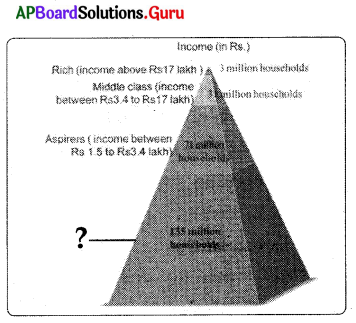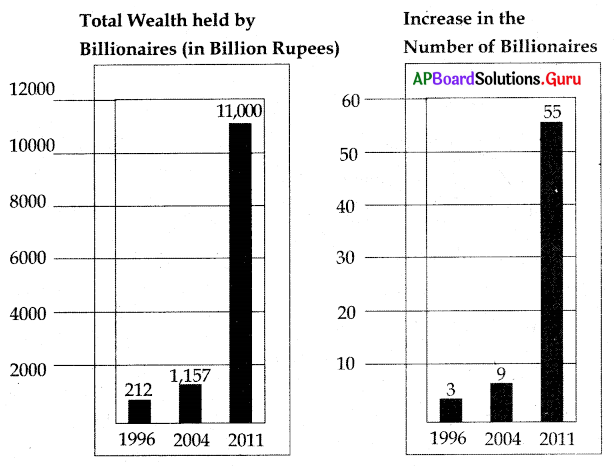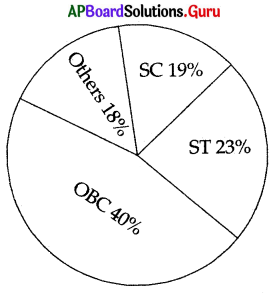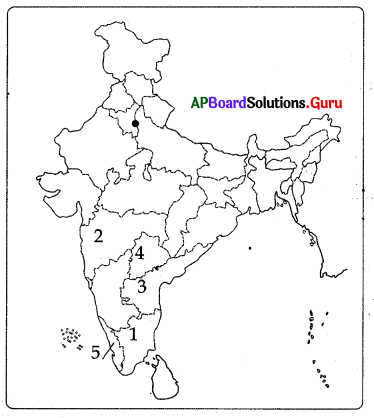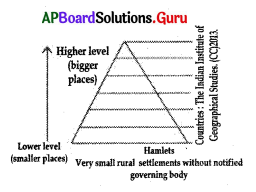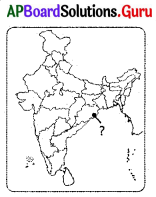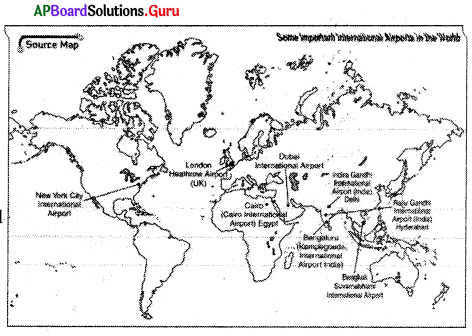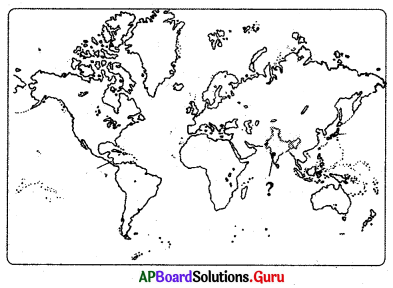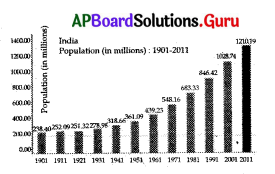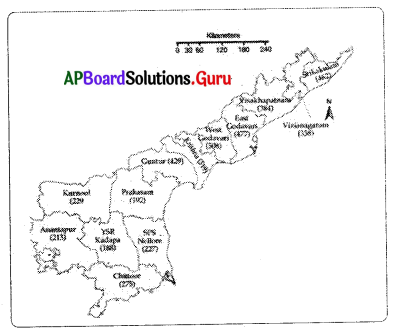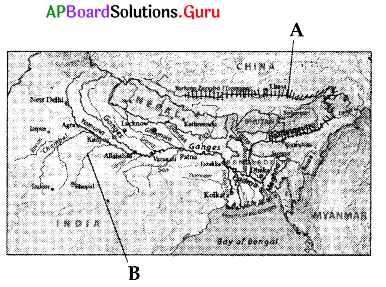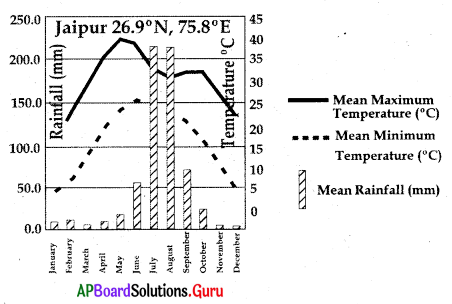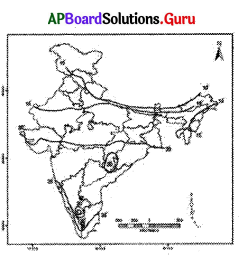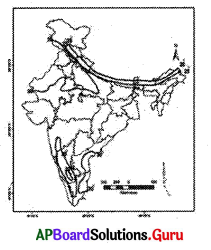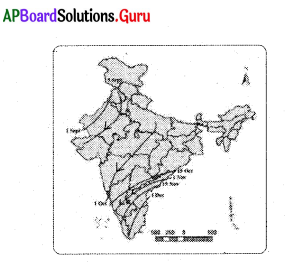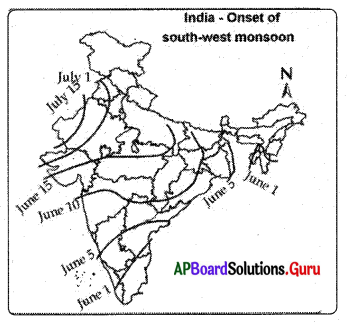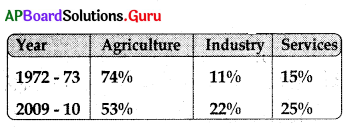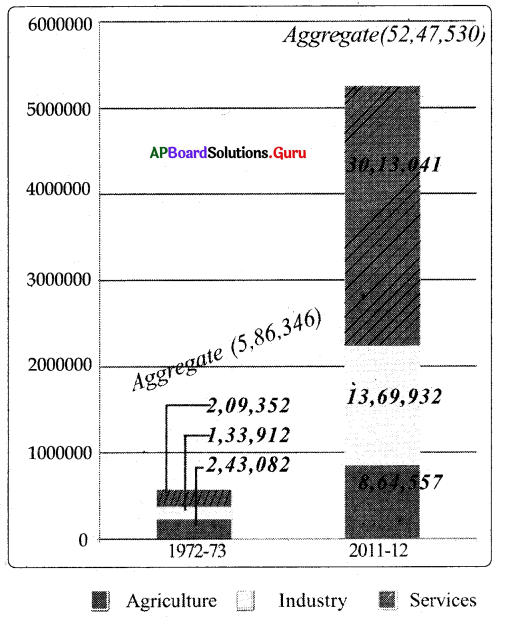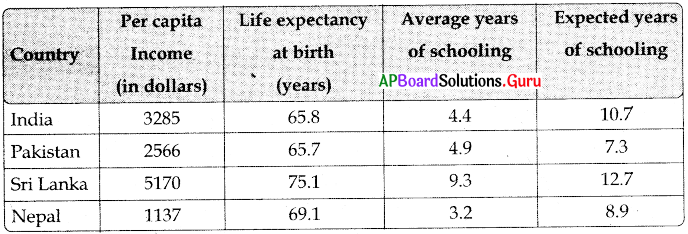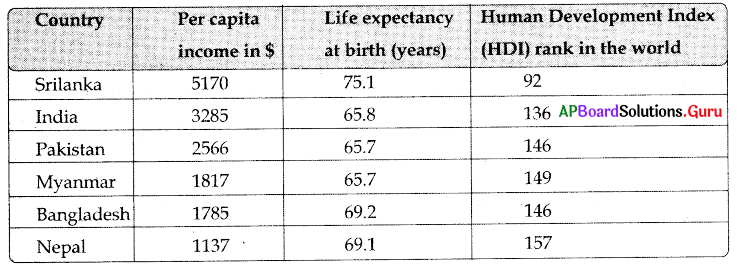Practice the AP 10th Class Social Bits with Answers Chapter 13 The World Between Wars 1900-1950 part 1 on a regular basis so that you can attempt exams with utmost confidence.
AP State Syllabus 10th Class Social Bits 13th Lesson The World Between Wars 1900-1950 part 1 with Answers
Question 1.
The Axis powers were led by
A) Austria
B) Italy
C) Japan
D) Germany
Answer:
D) Germany
Question 2.
These are the main reasons for World War?
A) Imperialism and league of Nations
B) Militarism and the Treaty of Versailles
C) Imperialism and Militarism
D) The Treaty of Versailles and the League of Nations
Answer:
C) Imperialism and Militarism
![]()
Question 3.
Hiroshima, Nagasaki cities belong to which country ?
A) Japan
B) America
C) Russia
D) China
Answer:
A) Japan
Question 4.
Which of the following is a Japan parliament ?
A) Duna
B) Reichstag
C) Diet
D) Bundstag
Answer:
C) Diet
Question 5.
Mussolini established the fascist party at a place called ………………….
A) London
B) Paris
C) Rome
D) Milan
Answer:
C) Rome
Question 6.
The conference on peace after the World War-I took place at ………………….
A) Vienna
B) Versailles
C) London
D) Berlin
Answer:
B) Versailles
Question 7.
Find out the correct statement.
A) The 21st century was a period of great expectations
B) Central powers won in World War-I
C) USA could not become a member as the US Congress refused to sanction the proposal of the President Wilson even though he was very active in the formation of League of Nations
D) International Women’s Suffragist movement, an organisation establi-shed in 1916.
Answer:
C) USA could not become a member as the US Congress refused to sanction the proposal of the President Wilson even though he was very active in the formation of League of Nations
Question 8.
In which of the following years British women acquired right to vote ?
A) 1915
B) 1918
C) 1919
D) 1921
Answer:
B) 1918
Question 9.
It is established to continue thepurpose of the League of Nations.
A) United Nations Organisation
B) World Bank
C) Capitalist group
D) Socialist group
Answer:
A) United Nations Organisation
![]()
Question 10.
Which country occupied Alsace and Lorraine Regions from France in 1871 ?
A) Britain
B) Italy
C) Russia
D) Germany
Answer:
D) Germany
Question 11.
The peace organisation prior to UNO was
A) SAARC
B) ASEAN
C) NAM
D) League of Nations
Answer:
D) League of Nations
Question 12.
Find the incorrect sentence
A) Period of first world war – 1914 to 1918
B) Formation of UNO – 24th October, 1945
C) International women’s suffragist movement -1914
D) Triple alliance – 1907
Answer:
D) Triple alliance – 1907
Question 13.
The port of Danzing belongs to this country.
A) Germany
B) Poland
C) Denmark
D) Belgium
Answer:
B) Poland
Question 14.
The important secret alliances during the two World Wars
1) Germany, Japan, Italy
2) Japan, Russia, Italy
3) Japan, Italy, China
4) England, France, Russia
A) 1, 2 True
B) 2, 4 True
C) 1, 4 True
D) 1, 3 True
Answer:
C) 1, 4 True
Question 15.
1) Germany signed on the Treaty of Versailles
2) Germany accepted the rule of Weimer
3) Nazis desired independent administration
A) 1 False
B) 2 False
C) 2 & 3 False
D) 1 & 3 False
Answer:
B) 2 False
Question 16.
The 20th century was a period of
A) Great expectations
B) Experiments
C) Dangerous developments
D) All of these
Answer:
D) All of these
Question 17.
Which of the following is incorrect set ?
A) Rise of Hitler in Germany – 1944
B) First World War – 1914 – 1918
C) Treaty of Versailles – 1919
D) Formation of UNO -1945
Answer:
A) Rise of Hitler in Germany – 1944
![]()
Question 18.
Which of the following statements is correct relating to Treaty of Versailles?
I) World War -I ended with the conference on peace at Versailles in 1918.
II) Germans thought the Treaty of Versailles was a diktat imposed on them.
A) I only
B) II only
C) I and II
D) None of these
Answer:
C) I and II
Question 19.
The Versailles is in ………………
A) Germany
B) France
C) Austria
D) Italy
Answer:
B) France
Question 20.
Triple alliance was led by
A) Italy
B) Austro-Hungary
C) Japan
D) Germany
Answer:
D) Germany
Question 21.
Which of the following is not one of the goals of United Nations organisation?
A) Establishing World Peace
B) Protecting Human Rights
C) Striving for the development of U.S.A
D) Promote Social Progress
Answer:
C) Striving for the development of U.S.A
Question 22.
Among the following find out the incorrect statement ?
A) At the beginning of 20th century, disparity across the world was, marked by the West and the Rest.
B) 20th century saw the rise of democracy and instances of dictatorship as well as making of new kingdoms.
C) After or during the First World War many countries changed over from monarchy rule to democracies.
D) Socialist societies wanted to build on the idea of equality and fraternity.
Answer:
B) 20th century saw the rise of democracy and instances of dictatorship as well as making of new kingdoms.
Question 23.
Find the incorrect set
A) 2nd World War – 1939 to 1945
B) Russian Revolution – 1917
C) Triple Entente – 1907
D) Rise of Hitler in Germany – 1923
Answer:
D) Rise of Hitler in Germany – 1923
Question 24.
The Ottoman empire was replaced by a democratic and secular state in ………………..
A) Yugoslavia
B) Afghanistan
C) Finland
D) Turkey
Answer:
D) Turkey
![]()
Question 25.
The regions occupied by Germany during World War – II are given below. Match them with years correctly.
i) Hungary and Rumania
ii) Bulgaria
iii) Yugoslavia and Greece
iv) Crete
v) Finland
a) June 1941
b) May 1941
c) April, 1941
d) March, 1941
e) November 1940
Which is the correct set
A) i – e, ii – d, iii – c, iv – b, v – a
B) i – a, ii – b, iii – c, iv – d, v – e
C) i – d, ii – c, iii – a, iv – b, v – e
D) i – b, ii – c, iii – a, iv – d, v – e
Answer:
A) i – e, ii – d, iii – c, iv – b, v – a
Question 26.
Weimar Republic was formed in which of the following country after World War -I?
A) Russia
B) America
C) Germany
D) Italy
Answer:
C) Germany
Question 27.
Statement (I): Ferdinand of Austria was murdered on 28th June 1914.
Statement (II): German tanks drove into Poland on 1st September 1939.
A) Statement – I is correct, statement – II is wrong.
B) Statement – I is.wrong, statement-II is correct.
C) Both statements are correct
D) Both statements are wrong.
Answer:
C) Both statements are correct
Question 28.
UN is a kind of world government. Based on which principle is it working?
a) Preserving peace
b) Upholding human rights
c) Respecting international law
d) Promoting social progress
A) a, b only
B) b, c only
C) a, b, c only
D) All the above
Answer:
D) All the above
Question 29.
In the phase “The West and the Rest” the West means
A) Newly independent countries
B) The countries which were exploited by the western countries
C) The countries which were experiencing economic growth
D) Newly industralised countries
Answer:
C) The countries which were experiencing economic growth
Question 30.
Arrange the following incidents in a chronological order
1) End of the First World War
2) Germany and the USSR entered into non aggression pact
3) Russian Revolution ‘
4) Russia became the USSR
A) 1, 2, 3, 4
B) 3, 1, 4, 2
C) 3, 2, 1, 4
D) 4, 3, 2,1
Answer:
B) 3, 1, 4, 2
Question 31.
The countries that were hot invited to the Treaty of Versailles were
A) England, Austria, Turkey, Italy
B) Russia, USA, Germany, France
C) Russia, Germany, Austria, Turkey
D) Japan, Italy, Germany, USA
Answer:
C) Russia, Germany, Austria, Turkey
![]()
Question 32.
The following is not appreciable regarding League of Nations
A) Took measures to establish peace after World War
B) Could not control the big powers for the reasons of own limitations.
C) Establishment of ICJ, WHO
D) Worked for eradicating malaria, trafficking of women
Answer:
B) Could not control the big powers for the reasons of own limitations.
Question 33.
The 20th century was called ‘The age of extremes’ by
A) Florence Owens
B) Eric Hobsbawm
C) Stalin
D) Kustodiev
Answer:
B) Eric Hobsbawm
Question 34.
Second World War started with the invasion of Germany on
A) Russia
B) Austria
C) France
D) Poland
Answer:
D) Poland
Question 35.
Archduke Franz Ferdinand belonged to
A) Serbia
B) Austria
C) Poland
D) Bulgaria
Answer:
B) Austria
Question 36.
The president of USA during World War -I
A) Thomson
B) Dulight D. Elsinhower
C) Woodrow Wilson
D) Cooldge
Answer:
C) Woodrow Wilson
Question 37.
The Head quarters of the UNO is in
A) Paris
B) Geneva
C) London
D) New York
Answer:
D) New York
Question 38.
Which of these countries are in Triple Entente group ?
A) Germany, Austria-Hungary, Italy
B) Russia, Austria-Hungary, Italy
C) USSR, USA, Italy
D) France, USSR, Great Britain
Answer:
D) France, USSR, Great Britain
![]()
Question 39.
The immediate cause of Second World War is ……………….
A) Aggressive Nationalism
B) Hitler’s invasion on Poland
C) Ferdinand’s murder
D) Secret Alliance
Answer:
B) Hitler’s invasion on Poland
Question 40.
Which of these countries are permanent members of UN?
A) France, UK, Germany, USA, India
B) France, China, USA, UK, Russia
C) USA, UK, Russia, Japan, Italy
D) USA, UK, Russia, France, Germany
Answer:
B) France, China, USA, UK, Russia
Question 41.
Hitler decided to attack U.S.S.R in the year
A) 1935
B) 1942
C) 1924
D) 1938
Answer:
B) 1942
Question 42.
When was USSR formed ?
A) 1918
B) 1917
C) 1924
D) 1939
Answer:
C) 1924
Question 43.
The following one was NOT the cause for the World Wars.
A) Militarism
B) Declaration of independence to all countries
C) Secret Alliances
D) Vengeful domination of Germany
Answer:
B) Declaration of independence to all countries
Question 44.
Which of the following countries is not a member of the Triple Alliance ?
A) Germany
B) Austria
C) France
D) Italy
Answer:
C) France
Question 45.
Which of the following organisations of the League of Nations have been functioning till today?
A) World Health Organisation
B) International Labour Organisation
C) International Court of Justice
D) All of these
Answer:
D) All of these
![]()
Question 46.
Eric Hobsbawm called 20th century as Age of Extremes for this reason
A) World Wars happened, huge loss to human life.
B) It experienced extreme war – peace efforts turning towards democracy, change in balance of powers.
C) Rise of Hitler, reasori for World War II.
D) All the above
Answer:
B) It experienced extreme war – peace efforts turning towards democracy, change in balance of powers.
Question 47.
What does this photograph explain?

A) The destitute pea pickers in California
B) The audience role in public place
C) Influence of Russian Socialism in older Europe
D) The life of peasants in India
Answer:
A) The destitute pea pickers in California
Question 48.
Find the incorrect set.
A) 1914 – First World War
B) 1946 – Establishment of UNO
C) 1919 – Establishment of League of Nations
D) 1918 – Vote power to women in Britain
Answer:
B) 1946 – Establishment of UNO
Question 49.
Which of the following is not the consequence of World War – II ?
A) 20 to 25 million people were killed
B) UNO was formed
C) Empires like Austria – Hungary, Russian, Ottoman and German came to an end
D) Ex-colonies rose to become independent nations
Answer:
C) Empires like Austria – Hungary, Russian, Ottoman and German came to an end
Question 50.
Which of the following statements is correct relating to League of Nations ?
I) Treaty of Versailles set up the League of Nations to prevent wars in the future.
II) US became the first member country in League of Nations.
A) I only true
B) II only true
C) Both I and II are true
D) Both I and II are false
Answer:
A) I only true
Question 51.
Which of the following is not a cause of World War – I?
A) Imperialism
B) Secret alliances
C) Militarism
D) Fear of socialism and USSR
Answer:
D) Fear of socialism and USSR
Question 52.
Among the following, which was not a long term factor of the World War – I ?
A) Imperialism
B) Murder of Ferdinand – I
C) Aggressive Nationalism
D) Militarism and Secret Alliance
Answer:
B) Murder of Ferdinand – I
Question 53.
This is not an example of aggressive nationalism.
A) Nazism
B) Communism
C) Fascism
D) Nazism and Fascism
Answer:
B) Communism
![]()
Question 54.
The first German Chancellor of united Germany was
A) William – I
B) William – I
C) Bismarck
D) Cavour
Answer:
C) Bismarck
Question 55.
Find the incorrect set.
A) Right to vote to British women – 1918
B) Non aggression pact between Germany and USSR – 1939
C) First World War – 1939 to 1945
D) Versailles Peace Conference -1919
Answer:
C) First World War – 1939 to 1945
Question 56.
In 1934 League of Nations had ……………. member countries
A) 58
B) 34
C) 43
D) 85
Answer:
A) 58
Question 57.
Which of the following is incorrect regarding ‘the age of extremes’ as per
Eric Hobsbawm?
A) Literacy levels and average life expectancy grew immensely
B) Women got their right to vote in this period.
C) Scientific knowledge rose to new heights unlocking the secrets of atom and life
D) New forms of art like movies did not emerge.
Answer:
D) New forms of art like movies did not emerge.
Question 58.
Find the incorrect set/statement.
A) Right to vote to British women – 1918
B) French alliance with Russia 1891
C) Facism began in Italy
D) Bismarck’s aliance with Austria – 1907
Answer:
D) Bismarck’s aliance with Austria – 1907
Question 59.
Which of the following events made USA to join the World War – II
A) Battle of Britain
B) Battle of Stalingrad
C) Attack on Pearl Harbour by Japan
D) Annexation of Austrian by Germany
Answer:
C) Attack on Pearl Harbour by Japan
Question 60.
The annual rally of Nazi party in Germany was held at
A) Berlin
B) Frankfurt
C) Nurnberg
D) Vienna
Answer:
C) Nurnberg
![]()
Question 61.
One of the ill effects of the ‘Great Depression
A) Over demand and rise in prices
B) Over demand and fall in prices
C) Decline in demand and rise in prices
D) Decline in demand and fall in prices
Answer:
D) Decline in demand and fall in prices
Question 62.
Adolf Hitler was a dictator in
A) Hungary
B) Germany
C) Italy
D) Sweden
Answer:
B) Germany
Question 63.
Which of these countries belongs to Triple Alliance ?
A) Germany
B) Great Britain
C) China
D) USA
Answer:
A) Germany
Question 64.
What is the Treaty that followed World War – I?
A) Treaty of Five Nations
B) Treaty of Boston
C) Treaty of Versailles
D) War Treaty of Allies
Answer:
C) Treaty of Versailles
Question 65.
In 1914 murder of ……………………. of Austria was one of the immediate provocation that led to First World War.
A) Sir Arthur Conan Doyle
B) Franklin D. Roosevelt
C) Adolf Hitler
D) Archduke Ferdinand
Answer:
D) Archduke Ferdinand
Question 66.
The following took place in 1919.
A) Treaty of Versailles
B) RTI Act originated
C) USSR was set up
D) Constitution was adopted in India
Answer:
A) Treaty of Versailles
Question 67.
The organisation, which has been set up and continuing for promoting worldpeace ………………..
A) United Nations Organisation
B) League of Nations
C) NATO
D) I.L.O
Answer:
A) United Nations Organisation
![]()
Question 68.
Before World War – II Poland had a defence pact with
A) Germany
B) Britain
C) Russia
D) China
Answer:
B) Britain
Question 69.
This logo belongs to

A) International Court of Justice
B) Statue of Liberty
C) Organisation on women’s suffragist movement
D) Universal Justice
Answer:
C) Organisation on women’s suffragist movement
Question 70.
After Second World War Ottoman Empire was replaced by
A) Democratic and secular state
B) Democratic and theocratic state
C) Democratic and socialist state
D) Democratic and military state
Answer:
A) Democratic and secular state
Question 71.
This was not a rival block during World Wars period.
A) Turkey, Germany, Austria
B) Germany, Austria, Hungary
C) Britain, France, Russia
D) Nigeria, Vietnam, Russia
Answer:
D) Nigeria, Vietnam, Russia
Question 72.
The Allies were not led by this ……………..
A) Britain
B) US
C) Germany
D) USSR
Answer:
C) Germany
Question 73.
This is not true with regard to World War – I
A) Austria declared war on Serbia as a citizen of Austria was murdered in Serbia
B) Allied powers like U.K, France came to the defence of Austria,
C) Germany supported Austria
D) Franz Ferdinand belonged to Austria
Answer:
A) Austria declared war on Serbia as a citizen of Austria was murdered in Serbia
Question 74.
The dissatisfaction for Germany over Peace at Versailles,
A) The Treaty of Versailles imposed some territorial penalties on Germany.
B) Germany was asked to retain the colonies of Africa but to retain Alsace and Lorrain.
C) Germany was asked to pull down its army strength.
D) Germany was asked not to have submarines.
Answer:
Question 75.
Find the correct matching
A) UNICEF-United Nations Educational, Scientific and Cultural Organis-ation
B) UNESCO-United Nations International Children’s Emergency Fund
C) Non – aggression pact between Germany and USSR – 1942.
D) The year of Great Depression -1929
Answer:
D) The year of Great Depression -1929
![]()
Question 76.
The suitable concept for the ‘pamphlet on world peace’ is
A) Eradication of Malaria
B) Eradication of Poverty
C) Ban on trafficking of women and children
D) Setting the disputes by peaceful negotiations
Answer:
D) Setting the disputes by peaceful negotiations
Question 77.
Which of the following is incorrect regarding right to vote to women ?
A) France – 1949
B) Britain – 1918
C) India – 1950
D) Switzerland – 1971
Answer:
A) France – 1949
Question 78.
Who came in support of Poland when Hitler invaded it in 1939
A) Britain and France
B) Japan and Austria
C) U.S.S.R and Britain
D) U.S.A
Answer:
A) Britain and France
Question 79.
Hilter invaded Poland as punishment for refusing to handover the port of ……………….
A) Keal
B) Kayak
C) Lothal
D) Danzig
Answer:
D) Danzig
Question 80.
This became a Weimer Republic after World War – I
A) Japan
B) Germany
C) Hungary
D) Turkey
Answer:
B) Germany
Question 81.
This is not the principle for forming U.N.O.
A) Preserving peace
B) Upholding human rights
C) Respecting international law
D) Creating markets for developed countries
Answer:
D) Creating markets for developed countries
Question 82.
Bismarck entered alliance with Italy in the year
A) 1879
B) 1881
C) 1882
D) 1878
Answer:
C) 1882
![]()
Question 83.
Bismark defeated France in the year
A) 1879
B) 1870
C) 1882
D) 1869
Answer:
B) 1870
Question 84.
The appeasement policy followed by western capitalist countries on Hitler
A) Supporting it against Soviet socialism
B) Encouraging it against Japan
C) Destroying the harbours of Germany
D) None of these
Answer:
C) Destroying the harbours of Germany
Question 85.
Mussolini belonged to
A) Germany
B) Italy
C) France
D) Russia
Answer:
B) Italy
Question 86.
League of Nations was formed in the year
A) 1885
B) 1920
C) 1918
D) 1905
Answer:
B) 1920
Question 87.
The period of World War I was…………….
A) 1939 – 1947
B) 1917 – 1939
C) 1939 – 1945
D) 1914 – 1918
Answer:
D) 1914 – 1918
Question 88.
Who was the leader of Nazi German force ?
A) Winston Churchill
B) Adolf Hitler
C) Joseph Stalin
D) Mussolini
Answer:
B) Adolf Hitler
Question 89.
The international organization formed immediately after World War – I was ……………..
A) World Bank
B) International Monetary Fund (I.M.F)
C) League of Nations
D) Asian Bank
Answer:
C) League of Nations
![]()
Question 90.
If a nation behaves aggressively with another country, the second country should ……………..
A) also behave agressively
B) show an attitude of give and take
C) try to solve the issue with political bilateral discussion
D) increase its weapons and army
Answer:
C) try to solve the issue with political bilateral discussion
Question 91.
How many countries participated in Versailles conference ?
A) 32
B) 37
C) 18
D) 25
Answer:
A) 32
★ Read the para and answer the question.
The same period saw the “Great Depression” causing massive unemployment and economic breakdown and two World Wars in which millions died and the lives of many more millions were dislocated.
Question 92.
The period of World Wars and the Great Depression
A) 1900 – 1915
B) 1900 – 1950
C) 1929 – 1960
D) 1850 – 1950
Answer:
B) 1900 – 1950
Graph showing Military expenditure
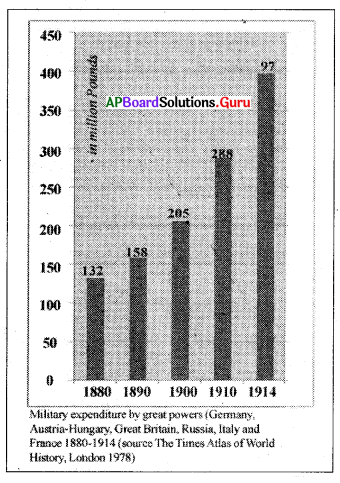
Question 93.
The Histograms in Graph shows ………………
A) Armament race in World War
B) Armament race during 1880 – 1914 of Great powers.
C) Germany’s Military expenditure
D) None of the above
Answer:
B) Armament race during 1880 – 1914 of Great powers.
Question 94.
Armaments were highest in the year ……………
A) 1910
B) 1880
C) 1914
D) 1890
Answer:
C) 1914
Question 95.
Which organisation prepared this graph?
A) Germany – Nazi Party
B) The Times Atlas of World History – London
C) Allied powers
D) Axis powers
Answer:
B) The Times Atlas of World History – London
Question 96.
How much increment can be noticed during 1880 – 1914 ?
A) 200 million pounds
B) 397 million pounds
C) 132 million pounds
D) 265 million pounds
Answer:
D) 265 million pounds
![]()
Look at the map and answer questions 97 – 100.
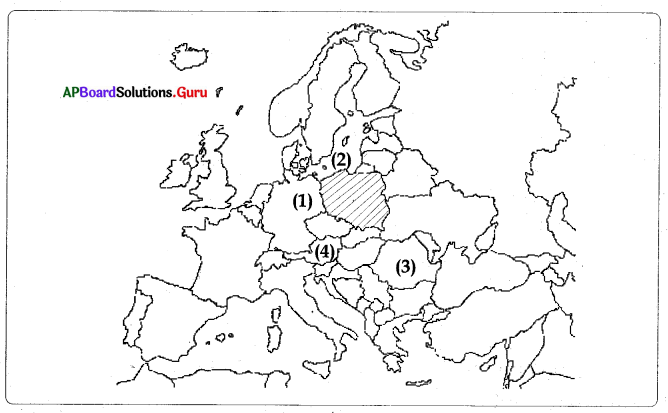
Question 97.
Name the country shown with shaded part.
A) Belarus
B) Poland
C) Ukraine
D) Romania
Answer:
B) Poland
Question 98.
No. ‘1′ shows
A) France
B) Germany
C) U.S.A
D) Italy
Answer:
B) Germany
Question 99.
What is the sea shown with No. ‘2’.
A) Red sea
B) Mediterranean sea
C) Baltic sea
D) Caspian sea
Answer:
C) Baltic sea
Question 100.
The immediate provocation for World War – I was the murder of Ferdinand. What is number represents his country
A) 1
B) 2
C) 3
D) 4
Answer:
D) 4
